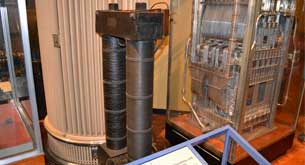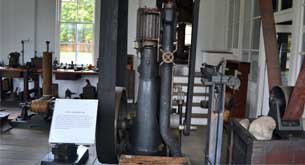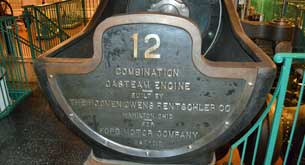Facts about DC Electricity
Posted by Admin / in Science Facts
DC electricity is an important concept for understanding circuits and electricity. Learn some interesting facts and important history about DC electricity. From early advances by Michael Faraday to modern circuit design, DC electricity is as relavent now than ever before. Find out more facts about DC electric.

Edison DC generator from 1880, produced 108 volts DC. Designed for the steamship Columbia.
The History of DC Electricity
- The first invention to convert mechanical energy to DC current was created by Michael Faraday in 1831 called the dynamo.
- This was near the end of the industrial revolution where steam power was the main source of power. Scientists were looking for a safer, more efficient power source to run machines and factories.
- In early 1880 Thomas Edison received a patent for a carbon filament light bulb. This light bulb was the first to last long enough to be useful. The light bulb changed the way people conducted business and how they lived.
- later in 1880 Edison formed the Edison Illuminating Company with a purpose of supplying DC power to homes and business who wanted to use his light bulb.
- Edison's power plants were very popular, but could only supply DC power for a radius of about 1 mile.
- By 1881 Lucien Gaulard from France and John Gibbs of England developed a working AC power generator that was much more efficient for transmitting power of a long distance than DC power.
- in 1889 George Westinghouse brought the technology to the United States which started the "war of the currents" with Thomas Edison.
- In the end AC power won the war because of the lower cost and technology advantages. The location where Edison's first DC power plant was opened in Lower Manhattan, New York, was still powered by DC power until 2005. The subway trains in New York still run on DC power.
- Most household electrical devices operate from DC current. DC power is typically provided by either batteries or AC current transformed to DC current.
- DC current is "Direct Current" where the current flows in only one direction.
- DC electrical current is measured in amps.
- DC electrical voltage is measured in volts.
- A voltmeter or digital multimeter is used to measure DC electrical current and DC voltage.
- The measurement of DC amps is actually considered measurement of flow of electrons.
- Batteries store DC power (current)
- Ohm's Law, V=I x R applies to a DC electrical circuit. V=voltage, I=DC current and R=resistance (in Ohms) (resistors in a DC circuit resist the flow of electricity)
- Work performed by an electrical DC current is known as power
- DC power is calculated by the result of voltage times current. The unit for DC power is watts.
- There are 4 major methods of making DC electricity including chemical generators (batteries), electromagnetic generator (hydroelectric turbine, wind turbine or generators), solar panel (sunlight to power) and thermoelectric generator (heating dissimilar metals).
Facts about DC Electricity

Dynamometer from Edison's Menlo Park Laboratory. Used to measure the efficiency of DC power dynamos compared to steam power.

Built in 1912, this piece of the much larger engine generator is only a piece of nine DC power generators that operated at the Highland Park Plant making Henry Ford's Model T cars.
